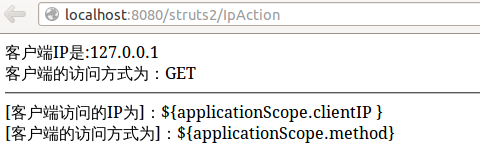实例1:实现客户端IP地址和访问方式输出到浏览器。
IpAction.java

package com.amos.web.action; import javax.servlet.http.HttpServletRequest; import javax.servlet.http.HttpServletResponse; import org.apache.struts2.ServletActionContext; import com.opensymphony.xwork2.ActionSupport; /** * @ClassName: IpAction * @Description: TODO * @author: amosli * @email:amosli@infomorrow.com * @date Jan 5, 2014 4:22:06 PM */ public class IpAction extends ActionSupport { private static final long serialVersionUID = -5488264951167516910L; public String execute() throws Exception { // 获取HttpServletRequest对象和HttpServletResponse对象 HttpServletRequest request = ServletActionContext.getRequest(); HttpServletResponse response = ServletActionContext.getResponse(); // 获取客户端ip地址 String clientIP = request.getRemoteAddr(); // 取得客户端的访问方式 String method = request.getMethod(); response.setContentType("text/html;charset=utf-8"); response.getWriter().write("客户端访问的IP为:" + clientIP + "<br>"); response.getWriter().write("客户端的访问方式为:" + method); return null; } }
ip_struts.xml
<?xml version="1.0" encoding="UTF-8" ?> <!DOCTYPE struts PUBLIC "-//Apache Software Foundation//DTD Struts Configuration 2.3//EN" "http://struts.apache.org/dtds/struts-2.3.dtd"> <struts> <package name="ip" namespace="/" extends="struts-default"> <action name="IpAction" class="com.amos.web.action.IpAction" method="execute"></action> </package> </struts>
struts.xml
<?xml version="1.0" encoding="UTF-8" ?> <!DOCTYPE struts PUBLIC "-//Apache Software Foundation//DTD Struts Configuration 2.3//EN" "http://struts.apache.org/dtds/struts-2.3.dtd"> <struts> <!-- 加载其他配置文件 --> <include file="config/ip_struts.xml"></include> </struts>
配置完成,部署运行,查看输出。
输出结果截图:

代码分析:
IpAction.java
struts2提供了使用ServletActionContext封装了常用的request和response对象,这里
>>1、使用ServletActionContext.getRequest()获取request对象,
>>2、ServletActionContext.getResponse()获得response对象。
>>3、使用request.getRemoteAddr()方法获取访问端的ip地址;
>>4、request.getMethod()方法获取客户端访问的方式;
ip_struts.xml
包名必须唯一,namespace可以省略,result属性这里没有用到,因为IpAction中return null,如果retrun "string" ,则必须配置result;
struts.xml
这里不需要配置其他的,只需要引入ip_struts.xml文件即可,使用include引入,引入的地址为相对路径,是否引入成功,查看tomcat启动时的提示信息,或者ctrl点击路径看能不能访问。
实例2:将实例1中的信息通过jsp输出
方法一:
IpAction.java

package com.amos.web.action; import javax.servlet.http.HttpServletRequest; import org.apache.struts2.ServletActionContext; import com.opensymphony.xwork2.ActionSupport; /** * @ClassName: IpAction * @Description: TODO * @author: amosli * @email:amosli@infomorrow.com * @date Jan 5, 2014 4:22:06 PM */ public class IpAction extends ActionSupport { private static final long serialVersionUID = -5488264951167516910L; public String execute() throws Exception { // 获取HttpServletRequest对象和HttpServletResponse对象 HttpServletRequest request = ServletActionContext.getRequest(); // HttpServletResponse response = ServletActionContext.getResponse(); // 获取客户端ip地址 String clientIP = request.getRemoteAddr(); // 取得客户端的访问方式 String method = request.getMethod(); // response.setContentType("text/html;charset=utf-8"); // response.getWriter().write("客户端访问的IP为:" + clientIP + "<br>"); // response.getWriter().write("客户端的访问方式为:" + method); request.setAttribute("clientIP", clientIP); request.setAttribute("method", method); System.out.println("method:"+method); return "toJSP"; } }
ip_struts.xml
<?xml version="1.0" encoding="UTF-8" ?> <!DOCTYPE struts PUBLIC "-//Apache Software Foundation//DTD Struts Configuration 2.3//EN" "http://struts.apache.org/dtds/struts-2.3.dtd"> <struts> <package name="ip" namespace="/" extends="struts-default"> <action name="IpAction" class="com.amos.web.action.IpAction" method="execute"> <result name="toJSP" type="dispatcher"> /ip.jsp </result> </action> </package> </struts>
ip.jsp是放在webapp目录下的

<%@page import="java.util.Date"%> <%@ page language="java" contentType="text/html; charset=UTF-8" pageEncoding="UTF-8"%> <!DOCTYPE html PUBLIC "-//W3C//DTD HTML 4.01 Transitional//EN" "http://www.w3.org/TR/html4/loose.dtd"> <html> <head> <meta http-equiv="Content-Type" content="text/html; charset=UTF-8"> <title>Insert title here</title> </head> <body> <% String method=request.getAttribute("method").toString(); String clientIP=request.getAttribute("clientIP").toString(); %> 客户端IP是:<%=clientIP %><br/> 客户端的访问方式为:<%=method %><br><hr> 客户端访问的IP为:${requestScope.clientIP }<br> 客户端的访问方式为:${requestScope.method}<br> </body> </html>
输出结果截图:
代码分析:
IpAction.java中使用request对象的setAttribute方法传值到request域中。如下所示:
request.setAttribute("clientIP", clientIP);
request.setAttribute("method", method);
并且return “toJSP”,不再局限于"success",其实只要ip_struts.xml中result中name属性值与其对应也就ok了。
ip_struts.xml 中使用转发默认方式(转发),name的属性值为"toJSP"与 IpAction.java中execute方法返回值相对应。然后将值转发到ip.jsp里
<result name="toJSP" type="dispatcher">
/ip.jsp
</result>
ip.jsp中采用了两种取值方式,第一种是基础的传值方式,传值是成功的,另外一种是简写的,一种都没成功,这里先帖出来,以后再慢慢研究吧。
TODO:servlet和jsp 的传值问题。
使用request对象的getAttribute方法来取值,然后再使用jsp的基本输出方式将值输出。
servlet有三个域对象:HttpServletRequest、ServletContext、HttpSession
方法二:
使用ServletContext如何进行传值呢?如下所示,IpAction类中的execute方法改写为:
// 获取HttpServletRequest对象和HttpServletResponse对象 HttpServletRequest request = ServletActionContext.getRequest(); // 获取servletcontext域 ServletContext servletContext = ServletActionContext.getServletContext(); // 获取客户端ip地址 String clientIP = request.getRemoteAddr(); // 取得客户端的访问方式 String method = request.getMethod(); // 将信息绑定到servletContext中 servletContext.setAttribute("clientIP", clientIP); servletContext.setAttribute("method", method); return "toJSP";
ip.jsp改写为:
<% String method=application.getAttribute("method").toString(); String clientIP=application.getAttribute("clientIP").toString(); %> 客户端IP是:<%=clientIP %><br/> 客户端的访问方式为:<%=method %><br><hr> [客户端访问的IP为]:${applicationScope.clientIP }<br> [客户端的访问方式为]:${applicationScope.method}<br>
输出结果为:

方法三(重点):
Ip_Action.java 中execute方法需要改的地方:
//获取HttpSession域 Map<String, Object> session = ActionContext.getContext().getSession(); //将信息绑定到servletSession中 session.put("clientIP", clientIP); session.put("method", method);
ip.jsp中需要改动的地方:
<% String method=session.getAttribute("method").toString(); String clientIP=session.getAttribute("clientIP").toString(); %> 客户端IP是:<%=clientIP %><br/> 客户端的访问方式为:<%=method %><br><hr> [[客户端访问的IP为]]:${sessionScope.clientIP }<br> [[客户端的访问方式为]]:${sessionScope.method}<br>
这里使用ActionContext获取session对象,再用getAttribute方法获取传过来的值。
输出结果为:

为什么ActionContext.getContext().getSession()会是Map集合?
struts2中有很多个默认拦截器(interceptor),在struts2源码中struts-default.xml中可以查看具体有哪些拦截器。interceptor-stack中有18个拦截器。
其中有一个拦截器将map中的值转为session值,例如,String method=map.get("method");HttpSession.setAttribute("method",method)
自动将map中的值转为session,这样做的目的是尽量少出现或者不出现ServletAPI,以达到解耦的作用。

